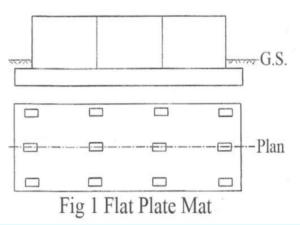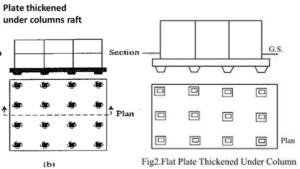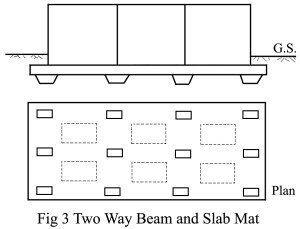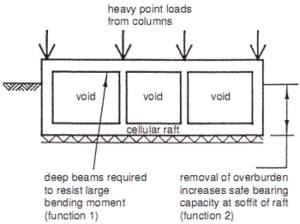Mat Foundation, Its types and Advantages
Mat foundation is also known as the raft foundation. It is a continuous thick concrete slab on the soil that extends the entire footprint of the building and increases the earth-bearing capacity power. This foundation supports the whole building loads and safely transfers them to the ground.
Raft/Mat foundation is used in those places where we have less bearing capacity of the soil. At those places, we use mat foundations to distribute the whole loads of the structure to the earth (When the footing area increases, then the soil load-bearing capacity will also increase) because this foundation reduces the stress on the soil at the same place.
There is no significant difference between the mat and raft foundations. Both are the same. It is a fundamental concept of stress in civil engineering. Weight divided by per unit area is called stress. E.g., if a building measuring 10 m x 7 m and its weight on it is 130 Tons so the result,
Stress = Weight / Area = 130 / 70 = 1.85 tons weight per m2.
This foundation is beneficial for basement structures. First, a waterproof membrane sheet is placed over the ground surface, and then 4″ PCC is poured to create a level base for the Mat/raft foundation. After the PCC, reinforcement steel bars are tied (cage) in place, and then the desired thickness of the concrete(According to the design) is poured.
Why do we use Mat Foundation?
There is a lot the critical reason for the use of mat foundations. We use this foundation if the
- The bearing capacity of the soil is weak and not capable of transferring the load of the building to the ground.
- A column is placed near the property line, and walls are so close that individual footing would overlap.
- If a deep foundation (Pile foundation) cost is higher than the raft foundation, we use it to make the structure economical.
- When a spread footing, columns can cover up to 50% of the foundation area.
Types of Mat/Raft Foundation
There are the following types of mat foundation,
- Flat plate raft
- Plate thickened under columns.
- Two-way slab and beam
- Piled mat
- Rigid frame raft
- Cellular mat foundation
1: Flat plate raft:
A flat plate raft is used in the small and lightweight load structure. This type of foundation is suitable when the soil is not compressible. The reinforcement bars are provided in both directions, top and bottom, in the form of a mesh (cage).
- A minimum of 6 inches of thick RCC slab is used in this foundation.

2: Thickened plate under columns:
The Slab thickness should be increased when the upcoming column loads are weighty. The flat plate foundation is not suitable in those structures where the column loads are very high, then the thickened flat plate is used.
- The heavy loads create the diagonal shear in the slab and create a negative bending moment on columns, so the thickness of the RCC slab under the column should be thickened.

3: Two-way slab and beam:
In this type of mat foundation, beams are placed in perpendicular directions, and all the beams are connected by an RCC slab. The columns are placed at the intersection of beams.
- A two-way slab and beam raft foundation is suitable when the columns are carrying unequal loads and the spacing is large between them.

4: Piled raft foundation:
This foundation is supported by piles in the soil. The piled raft foundation is suitable for the ground of high compressibility and where the water table is high. Piled raft foundation is mainly used for high-rise buildings.
- The piles were used to reduce the amount of soil settlement(With time) and increase the soil load-bearing capacity.

5: Rigid frame raft:
A rigid frame mat is used when the columns have a very high load on them. In rigid frame mat design, the basement RCC wall acts as a deep beam or ribs.
- If the foundation depth is greater than 90 cm, then the rigid frame raft is used.

6: Cellular mat foundation:
It is also termed a box mat foundation. In the cellular mat foundation, the structures of boxes are formed, and the walls of every box act as beams. The walls are connected by slabs at the top and bottom.
- This type of foundation is suitable for loose soil.

Advantages:
- The foundation and ground floor slab is poured simultaneously, which reduces our construction time and material.
- It requires less excavation.
- It is provided where a shallow foundation is possible, but the condition of the soil is poor.
- Reduces the cost of constructing a floor slab (But not entirely economical).
- It helps in the transferring of loads over a wide area.
- It shows good resistance and cannot slide during a flood.
- We can handle more heavy loads as compared to other types of foundations.
Disadvantages:
- A raft foundation requires a large quantity of steel and concrete.
- This foundation is costly (The volume of footing was increasing).
- It is not suitable and used for domestic home construction.
- Unique measurement is needed in the case of concentrated loads.
- In the mat foundation, skilled labourers are required.
Add a Comment
You must be logged in to post a comment.

thanks
Raju Welcome